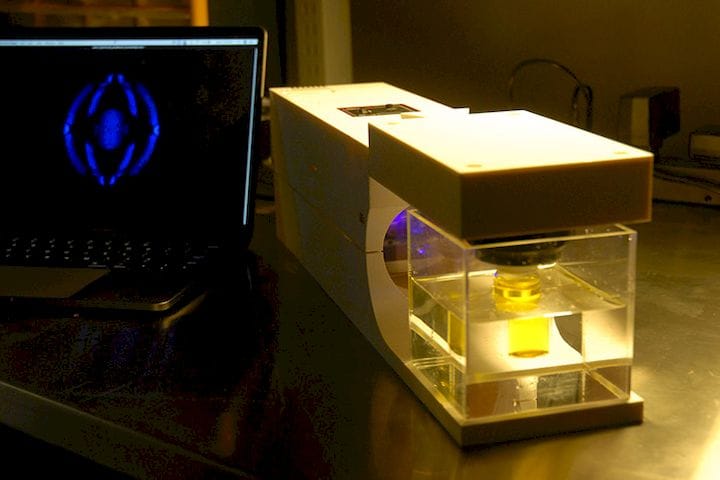![A new resin process, “CAL” [Source: UC Berkeley]](https://fabbaloo.com/wp-content/uploads/2020/05/cal-ov_result_img_5eb09d760d8a9.jpg)
Researchers at UC Berkeley and Lawrence Livermore National Laboratory have developed an unusual 3D printing process that mimics 3D scanning, except in reverse.
Their new photo-polymerization process, dubbed “Computed Axial Lithography” or, CAL, involves rotating the build volume during printing. It’s certainly a different process, but there could be many challenges to making it feasible for commercial use.
Virtually all 3D printers to today’s date use the layer approach, where a 3D model is deconstructed in software to “slices”, each of which is sequentially produced using whichever making process: extrusion, binder jetting, deposition, sintering, photo-polymerization, etc. The CAL process doesn’t use layers at all.
The only other 3D printing process I’ve seen that does not use the layer approach is one made by MIT and Steelcase, where they move an extruder through a stiff gel to deposit strands of material in 3D. The gel is strong enough to hold the extrusion while it solidifies. This is much like “drawing” a 3D object without regard to layers.
The CAL process does not use layers, but it also does not “print it all at once” in a “syrupy liquid”, as has been extensively reported by numerous mass media publications, who are desperately seeking a Star Trek replicator replicant [See what I did there?] That’s not at all what CAL does.
How does it work? Well, it is quite fascinating, and in retrospect is so obvious it should have been discovered a long time ago.
Let’s first look at a common method of 3D scanning: photogrammetry. In this process a series of images are taken of a static subject from all directions. Each view is slightly different, particularly the edge of the subject’s silhouette. In software these 2D images are processed using sophisticated algorithms to create a 3D model of the object.
The algorithms do this by “projecting” the 2D image in a virtual 3D space and overlapping them. The points of confluence after repeated image processing end up being the nodes of the 3D model.
It’s a fantastic method for 3D scanning, and is so easy to build that there you can do it with your smartphone or any camera, as we demonstrated in our Museum Series.
The CAL process essentially does this in reverse. Instead of “taking 2D images”, they simply generate them from an existing 3D model. These images are numerous, perfectly aligned and from precisely measured intervals in a 360 degree circuit around the object.
![The CAL 3D printing process [Source: UC Berkeley]](https://fabbaloo.com/wp-content/uploads/2020/05/cal-process_result_img_5eb09d765d56e.jpg)
Then, these images are simply displayed from a conventional projector onto a cylindrical volume of photopolymer resin. The trick is that the resin chamber rotates at exactly the same rate as the sequence of images are displayed, as if you were moving around the object doing photogrammetry.
The secret sauce of CAL is in the resin. Like all photopolymer resins, it solidifies when exposed to certain frequencies of light. That’s how SLA, DLP and other resin-based 3D printing processes work. The secret is exactly how much light energy is required to trigger solidification. If too little, nothing happens.
As the images are displayed, parts of the 3D model that should exist are repeatedly exposed to light energy as the cylinder rotates, because, of course, images will show something at that 3D position. Over time the repeated exposure to that light energy eventually triggers solidification – in positions where solid material should exist.
![Samples of 3D prints made with the CAL process [Source: UC Berkeley]](https://fabbaloo.com/wp-content/uploads/2020/05/cal-samples_result_img_5eb09d76a651f.jpg)
This is quite a brilliant idea!
There are some advantages to this approach:
-
It should be very inexpensive to produce CAL machines, as you simply need a rotating cylindrical reservoir, a projectors and some control elements.
-
There is no need for a sophisticated tank release mechanism as seen in SLA machines, because the solidification occurs within the material, not on the bottom edge of the tank.
-
The lack of need for tank release procedures should speed up the printing to an essentially continuous process.
-
In advanced SLA systems like Carbon’s or others that have a tank release method, the machines still must wait for viscous resin to flow in to be ready for the next layer; no such issue with CAL as the resin is already in place.
-
It would be possible to “print on top of” an existing object if placed at the center of the build chamber.
-
There doesn’t seem to be any need for support structures with CAL, which will speed up the printing lifecycle.
But before you get your hopes up too high, there are some big challenges with CAL:
-
The light energy must pass deeply through the resin to get to target positions. This means that the resin must be relatively transparent, making it likely many types of advanced non-transparent resins could not be used with CAL.
-
The need for transparency likely means there could be a maximum build volume based on the degree of transparency, thus CAL systems are likely to be small volume.
-
Photogrammetry has issues with some complex object geometries. It’s possible to “hide” parts of an object so that they are not possible to see from 360 degrees, thus it may be that CAL is not feasible for certain types of objects.
That last point might be addressed by having rotations in multiple axes, as is also done in photogrammetry: to scan the top of a subject’s head you must place the camera over top – there is no equivalent of that with CAL, at least not yet.
Regardless of the challenges, CAL is an amazing development that could, if properly commercialized, find a niche market, likely within the jewelry market for speedy manufacturing.
Via Science and UC Berkeley











A research thesis details the incredibly complex world of volumetric 3D printing. We review the highlights.